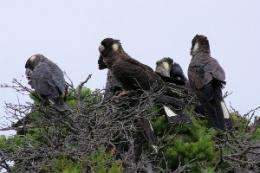Perth slowly devouring its black Cockatoo species

WA Museum’s ornithology curator says black cockatoos, which once flocked to the Swan Coastal Plain in tens of thousands, could be extinct within 50 years.
“They are iconic large forest cockatoos that were once widespread and common in huge numbers on the Swan Coastal Plain,” Dr. Ron Johnstone, who is also an Adjunct Professor at Murdoch University said.
“It’s been death by a thousand cuts as the vegetation has been reduced.”
He said there were three species - Carnaby’s Cockatoo (Calyptorhynchus latirostris), Baudin’s Cockatoo (Calyptorhynchus baudinii) and the Forest Red-tailed Black Cockatoo (Calyptorhynchus banksii naso) - that nested in tree hollows, and moved south and west after nesting season to feed on nuts, nectar and wood-boring grubs and insects.
Prof Johnstone said nuts from the extensive pine plantations (Pinus radiata) introduced in the 1920s and 30s provided a valuable diet replacement for Carnaby’s cockatoos as developers gradually cleared Perth’s banksia heathlands for housing subdivisions.
“(When) a lot of the juveniles are just fledged… these areas became a very valuable source of food (which) the birds were able to use up very quickly because the pines are producing cones during the period when they first arrive,” he said.
Prof Johnstone said the destruction of remnant bushland continues. He gave the example of UWA endowment lands in Floreat.
“That flock (of Carnaby’s black cockatoos) around the University of WA grounds in Underwood Avenue there is the last surviving flock in the western suburbs of Perth,” he said.
“Now if you just continue to degrade and reduce the amount of available foraging habitat you will lose that flock.”
Some of the pine plantations have also been cleared and the remainder are likely to disappear to meet the housing needs of a rapidly-growing capital city.
Professor Johnstone said developers and householders can choose to plant any of a variety of endemic and exotic trees that will help the black cockatoos survive.
He would also like to see a planning policy that includes planting of suitable trees in new subdivisions, and the retention of some of the mature trees to provide some feed while new trees grow to maturity.
This even includes the exotic Pinus radiata.
“Even where the plantations are removed we should try and keep at least a fringe of pines that will provide food which will allow the birds to adjust a bit.”
Provided by ScienceNetwork Western Australia

















